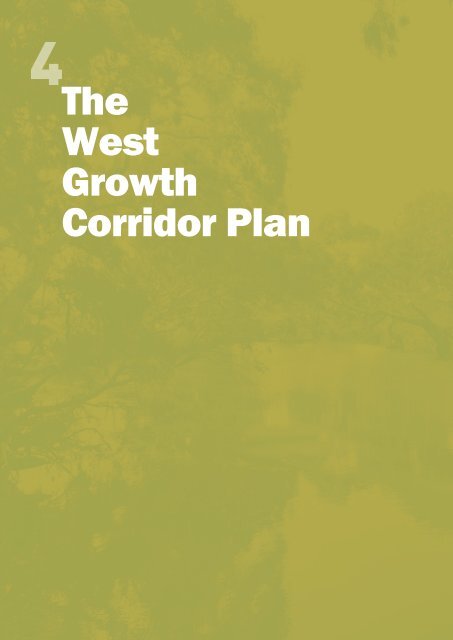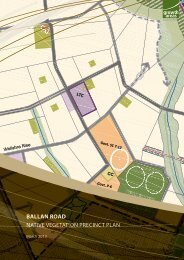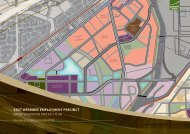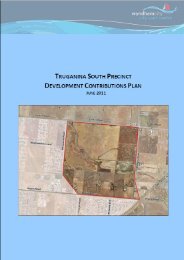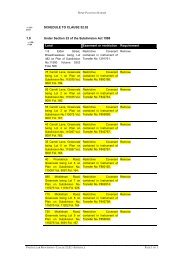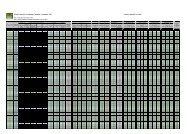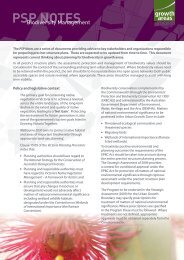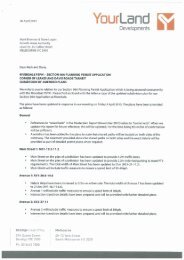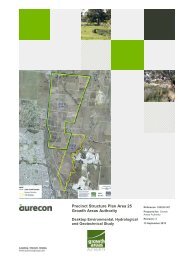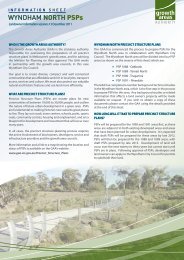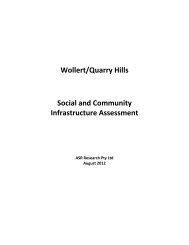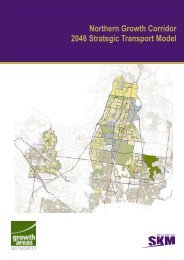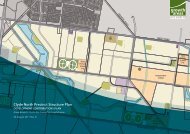The West Growth Corridor Plan - Growth Areas Authority
The West Growth Corridor Plan - Growth Areas Authority
The West Growth Corridor Plan - Growth Areas Authority
You also want an ePaper? Increase the reach of your titles
YUMPU automatically turns print PDFs into web optimized ePapers that Google loves.
<strong>The</strong><br />
<strong>West</strong><br />
<strong>Growth</strong><br />
<strong>Corridor</strong> <strong>Plan</strong><br />
36 | <strong>Growth</strong> corridor plans
<strong>Growth</strong> corridor plans |<br />
37
Existing Urban<br />
Urban <strong>Growth</strong> Boundary<br />
Freeway<br />
Arterial Road<br />
Local Collector Road<br />
Principal Freight Network<br />
Railway Line<br />
Rail Station<br />
Opportunity for future Rail Station<br />
Rail Stabling<br />
Principal Public Transport Network<br />
Specialised Town Centre<br />
Central Activity Area<br />
Principal Town Centre<br />
Major Town Centre<br />
Industrial<br />
Business<br />
Business with Residential<br />
Residential<br />
Proposed Regional Open Space<br />
Existing Open Space<br />
Regional Active Open Space (under investigation)<br />
Biodiversity Values<br />
Landscape Values<br />
Non-urban/Utilities<br />
Potential Urban<br />
Quarry<br />
Rivers & Creeks<br />
Waterway <strong>Corridor</strong><br />
Investigation Area<br />
Inclusion of arterial roads in the plans does not<br />
indicate a commitment to funding or<br />
declaration as a state arterial road<br />
Infrastructure items shown are indicative and<br />
will require further investigation<br />
1:115000 @ A3<br />
13 JUNE 2012<br />
0 1 2 3 4 5<br />
Base map is reproduced with permission<br />
from Melway Publishing Pty. Ltd. 2011.<br />
NOTES<br />
Melton Tourism Precinct<br />
Proposed Kororoit Creek Regional Park (exact boundary to be<br />
determined)<br />
Potential location for <strong>West</strong>ern Interstate Freight Terminal<br />
Proposed Werribee Township Regional Park (exact boundary to be<br />
determined)<br />
Protect the planned rail freight spur line between the OMR corridor<br />
and Melton rail line from sensitive uses by including a buer of<br />
non-residential<br />
Protect the Boundary Road freight route from sensitive uses by<br />
including a buer of non-residential<br />
Potential rail stabling<br />
Water management site subject to further investigation<br />
38 | <strong>Growth</strong> corridor plans<br />
See Note<br />
See Note<br />
See Note<br />
See
Note<br />
See Note<br />
See Note<br />
See Note<br />
See Note<br />
<strong>Growth</strong> corridor plans | 39
4.1 COnTEXT<br />
Melbourne’s western region is<br />
one of the fastest growing in<br />
australia. the area covered by<br />
the west <strong>Growth</strong> corridor plan<br />
will eventually accommodate a<br />
population of 377,000 or more<br />
people and have the capacity to<br />
accommodate at least 164,000<br />
jobs.<br />
the region has a strong<br />
manufacturing and logistics<br />
base, and it will continue to<br />
play a vital role in meeting<br />
Victoria’s industrial and logistics<br />
needs. however, communities<br />
in Melbourne’s west are heavily<br />
reliant on the cBd and inner west<br />
for jobs and services, and this<br />
places considerable pressure on<br />
the transport network.<br />
the future development of<br />
Melbourne’s west will be<br />
substantially shaped by the<br />
following significant transport<br />
projects:<br />
> > the regional rail link (rrl)<br />
project, which will provide<br />
tracks to the north of werribee<br />
to carry Vline services from<br />
Geelong and beyond, to free<br />
up the congested werribee<br />
line to enable an improved<br />
40 | <strong>Growth</strong> corridor plans<br />
THE WEST<br />
<strong>Growth</strong> <strong>Corridor</strong> <strong>Plan</strong><br />
metropolitan service to<br />
werribee and eventually to<br />
wyndham Vale. two new<br />
stations are proposed on the<br />
rrl, at wyndham Vale and<br />
tarneit, with opportunities<br />
for four more stations in the<br />
longer term;<br />
> > the proposed outer Metropolitan<br />
ring (oMr) transport<br />
corridor – this will enhance<br />
connectivity between key<br />
international transport<br />
hubs including the port of<br />
Melbourne and Melbourne<br />
airport, and provide high<br />
speed road and rail transport<br />
links for freight and people<br />
across the west and north<br />
metropolitan area;<br />
> > the Melton rail line corridor<br />
– new stations identified at<br />
toolern and paynes road,<br />
and an upgraded station<br />
at rockbank, will provide<br />
an opportunity for transit<br />
oriented development along<br />
this corridor; and<br />
> > the proposed western<br />
interstate Freight terminal at<br />
truganina. a new intermodal<br />
freight terminal will significantly<br />
improve Melbourne’s<br />
freight handling capacity and<br />
reinforce the economic importance<br />
of Melbourne’s west.<br />
creating greater local self<br />
containment, job and housing<br />
diversity, and improved transport<br />
links are priorities for the western<br />
metropolitan region. the west<br />
<strong>Growth</strong> corridor plan seeks to<br />
address these priorities by:<br />
> > improving road, public transport<br />
and freight networks<br />
across the region;<br />
> > Extending the western industrial<br />
node, and connecting<br />
it to a new freight terminal<br />
and the broader transport<br />
network;<br />
> > creating a diversity of new<br />
communities, well serviced<br />
by public transport and with<br />
very high amenity by building<br />
on natural features such as<br />
regional parklands, creeks<br />
and waterways, and creating<br />
high quality town centres and<br />
urban areas; and<br />
> > creating attractive and accessible<br />
locations for a wide<br />
range of jobs, investment, and<br />
services – including in six new<br />
higher order town centres.
4.2<br />
<strong>The</strong> <strong>West</strong> <strong>Growth</strong><br />
<strong>Corridor</strong> will play a significant<br />
role in the diversification<br />
of the broader western region<br />
over time. <strong>The</strong> Hopkins Road Business<br />
Precinct, and the Werribee Employment<br />
Precinct, together with existing and planned<br />
Principal and Major Town Centres, will provide significant<br />
new opportunities for living, jobs, investment and<br />
services within the region.<br />
<strong>The</strong> region will also continue to play a vital role in meeting Victoria’s<br />
industrial, freight and logistics needs over the long term, whilst<br />
diversifying the employment offer of the region. <strong>Plan</strong>ned upgrades<br />
to the freeway and freight facilities in Melbourne’s west will reinforce its<br />
importance to the industrial sectors.<br />
Each local neighbourhood will have its own character, defined by its<br />
natural setting, and opportunities to integrate locally distinctive features<br />
into the development of the <strong>Growth</strong> <strong>Corridor</strong> will be maximised. <strong>The</strong>se<br />
include waterways, hills, regional parks and open space, and biodiversity<br />
reserves, as well as more distant views to the hills to the <strong>West</strong> and<br />
North, and to the CBD.<br />
<strong>Growth</strong> corridor plans | 41
4.3 lAnDSCAPE,<br />
EnViROnMEnT AnD<br />
OPEn SPACE<br />
the west <strong>Growth</strong> corridor is characterised<br />
by its grasslands biodiversity<br />
and the major waterways<br />
that connect it to inner Melbourne<br />
and port phillip Bay, as well as by a<br />
range of cultural heritage values.<br />
these features provide significant<br />
opportunities to address the broad<br />
needs of the region by creating<br />
new active and passive recreation<br />
areas alongside waterways and<br />
in areas with high landscape or<br />
biodiversity values.<br />
the <strong>Growth</strong> corridor plan recognises<br />
this wide range of values.<br />
combined, they make up an<br />
integrated open space network for<br />
Melbourne’s west. this network<br />
provides an important natural<br />
setting for the entire western<br />
corridor and will make a major<br />
contribution to the amenity and<br />
42 | <strong>Growth</strong> corridor plans<br />
sense of place for future communities.<br />
residents and visitors will be able<br />
to access the open space via a<br />
comprehensive trail network that<br />
will extend throughout the west<br />
<strong>Growth</strong> corridor.<br />
4.3.1 landscape<br />
the west <strong>Growth</strong> corridor is<br />
characterised by a flat to undulating<br />
landscape that is dissected<br />
by a number of waterways and<br />
enclosed by distant views to the<br />
You Yangs and Brisbane ranges to<br />
the west, and the Great dividing<br />
range to the north. the key<br />
landscape features that form part<br />
of the broader setting for urban<br />
development as shown in the<br />
images below include:<br />
> > the natural drainage system<br />
across the <strong>Growth</strong> corridor<br />
– this will form the spine<br />
of the open space network<br />
which connects different<br />
parts of the corridor in<br />
both visual and landscape<br />
terms. the werribee river<br />
and Kororoit, skeleton/dry,<br />
davis and lollipop creeks are<br />
particularly important in this<br />
regard;<br />
> > Mount atkinson and Mount<br />
cottrell are important<br />
landscape features. they will<br />
be preserved and, where<br />
relevant, urban areas will<br />
benefit from vistas to these<br />
features from a range of<br />
vantage points across the<br />
<strong>Growth</strong> corridor;<br />
> > distant views to the cBd, You<br />
Yangs, Brisbane ranges and<br />
the Great dividing range; and<br />
> > Finer grained and recurring<br />
elements across the landscape<br />
such as the dry stone walls<br />
and original 19th century<br />
mile grid subdivision pattern<br />
will be incorporated into the<br />
new urban landscape where<br />
possible.
4.3.2 Biodiversity<br />
the west <strong>Growth</strong> corridor has<br />
significant biodiversity values<br />
including threatened communities<br />
of natural temperate Grasslands of<br />
the Victorian Volcanic plain. threatened<br />
fauna species that utilise<br />
ecological communities as well<br />
as degraded landscapes include<br />
striped legless lizard, Golden<br />
sun Moth (GsM), and Growling<br />
Grass Frog (GGF). threatened<br />
flora species exist throughout the<br />
<strong>Growth</strong> corridor with populations<br />
of spiny rice flower, and large<br />
Fruit Groundsel, occurring in a<br />
number of locations.<br />
the major waterways of werribee<br />
river and Kororoit creek are<br />
biodiversity corridors that provide<br />
important habitat and connectivity<br />
through the <strong>Growth</strong> corridor<br />
for species such as the Growling<br />
Grass Frog.<br />
two large grasslands reserves<br />
are to be established outside<br />
the Urban <strong>Growth</strong> Boundary in<br />
Melbourne’s west. the western<br />
Grasslands reserve (totalling<br />
15,000ha) will ensure the long<br />
term conservation of this nationally<br />
threatened natural temperate<br />
Grasslands ecosystem.<br />
the following biodiversity values<br />
are recognised by the west <strong>Growth</strong><br />
corridor plan:<br />
> > large areas of habitat<br />
for the GsM which also<br />
have confirmed records of<br />
nationally important plants<br />
such as spiny rice Flower;<br />
> > habitat for the GGF along the<br />
werribee river, Kororoit creek<br />
and its tributaries, as well as<br />
lollypop and davis creeks,<br />
and deanside wetlands;<br />
> > the clarke road grasslands,<br />
which supports one of two<br />
remaining sites of the small<br />
Golden Moths orchid in the<br />
world, as well as spiny rice<br />
flower. this area will form<br />
part of the wider Kororoit<br />
creek regional park. an<br />
area of approximately 50 ha<br />
extending to the north of the<br />
Kororoit creek will also be<br />
protected for conservation<br />
to incorporate spiny riceflower,<br />
Golden sun Moth<br />
habitat, ephemeral wetlands<br />
and high quality remnant<br />
grassland. the finalisation<br />
of the boundaries for the<br />
regional park will consider the<br />
inclusion of this area in the<br />
park;<br />
> > a small but important site to<br />
the north-west of the clarke<br />
road grasslands supports<br />
many spiny rice-flower in<br />
high quality native grassland<br />
habitat and will be protected<br />
for conservation;<br />
> > the truganina cemetery<br />
and its edges contain several<br />
populations of nationally<br />
threatened plant species;<br />
<strong>Growth</strong> corridor plans | 43<br />
GRowth CoRRIdoR PLaN : MELBOURNE WEST
the completion of the<br />
truganina south Golden sun<br />
Moth reserve on woods road;<br />
> > the deer park Quarry<br />
Grasslands, which provides<br />
habitat for the striped legless<br />
lizard and the spiny rice<br />
flower;<br />
> > the area between the railway<br />
line and western Freeway at<br />
rockbank supports a large<br />
population of large-fruit<br />
Groundsel and spiny riceflower<br />
and will be protected<br />
for conservation; and<br />
> > the area of high quality native<br />
grassland south of Greigs<br />
road will also be protected<br />
to conserve a very large<br />
population of spiny riceflower<br />
contiguous with the<br />
western Grassland reserves.<br />
44 | <strong>Growth</strong> corridor plans<br />
4.3.3 Drainage<br />
significant floodplains exist along<br />
Kororoit creek and the werribee<br />
river, which are important features<br />
of the western plains landscape.<br />
these major waterways, together<br />
with the numerous smaller<br />
tributaries and local wetlands,<br />
include areas of cultural heritage<br />
and provide habitat for significant<br />
native flora and fauna.<br />
the lower reaches of the werribee<br />
river flow through coastal<br />
wetlands which form part of the<br />
port phillip Bay (western shoreline)<br />
and Bellarine peninsula<br />
ramsar site. ramsar3 wetlands<br />
require a high level of control<br />
over the quality and quantity of<br />
surface water discharge, which will<br />
affect management of stormwater<br />
entering the werribee river.<br />
the alignments of the outer<br />
Metropolitan ring road (oMr)<br />
and regional rail link (rrl) corridors<br />
will also affect waterways and<br />
flood plains.<br />
all of these issues will need to be<br />
considered in development of<br />
stormwater systems servicing the<br />
west <strong>Growth</strong> corridor.<br />
3 ramsar wetlands are wetlands of international importance listed under the convention<br />
on wetlands also known as the ramsar convention. the convention was signed in<br />
1971 at a meeting in the town of ramsar, in iran. the aim of the convention is to halt the<br />
worldwide loss of wetlands and to conserve those that remain.
You Yangs Park<br />
4.3.4 Regional Parks<br />
and Open Space<br />
a new regional park is currently<br />
under development along toolern<br />
creek, to the south of Melton.<br />
additional regional parks are<br />
identified along Kororoit creek,<br />
(west of caroline springs); and the<br />
werribee township regional park<br />
on the werribee river. the indicative<br />
boundaries of these parks<br />
are shown on the west <strong>Growth</strong><br />
corridor plan. Further biodiversity<br />
information is required to finalise<br />
the northern boundary of the<br />
Kororoit creek regional park, and<br />
further drainage information is<br />
Melton Woodgrove<br />
Melton<br />
Toolern<br />
Toolern Vale Regional Park<br />
<strong>West</strong>ern Plains Grassland Reserve<br />
Rockbank North<br />
Rockbank South<br />
Werribee Township Regional Park<br />
Wyndham Vale<br />
required to finalise the western<br />
and northern boundaries of the<br />
werribee township regional park.<br />
the proposed western Grassland<br />
reserves will also provide<br />
significant passive open space<br />
opportunities. public access to<br />
these reserves will focus visitors<br />
into areas where the impact on<br />
biodiversity can be minimised.<br />
two potential locations for a<br />
regional active open space facility<br />
are identified, adjoining the Kororoit<br />
creek regional park and along<br />
Kororoit creek close to the rockbank<br />
town centre. these facilities<br />
are intended to meet a need for<br />
Kororoit Creek Regional Park<br />
Hopkins Rd<br />
Sayers Road<br />
Werribee<br />
Plumpton<br />
Tarneit<br />
Werribee Zoo<br />
Werribee<br />
Employment<br />
Precinct<br />
Sydenham<br />
sports with a regional catchment.<br />
the delivery of these facilities will<br />
need to be further investigated<br />
before any final decisions can be<br />
made.<br />
these parks will be connected by a<br />
series of trails focused particularly<br />
along the waterways. some of<br />
these will form part of the Mtn,<br />
and others will form more local<br />
trails to be provided through psps.<br />
the plan below explains how<br />
all forms of open space will be<br />
integrated.<br />
Melb Airport<br />
Sunshine<br />
Point Cook Coastal Park<br />
<strong>West</strong><br />
Integrated><br />
Open>Space<br />
Concept><strong>Plan</strong><br />
Central Activity Area<br />
Principal Town Centre<br />
Major Town Centre<br />
Train Station<br />
Future Station<br />
<strong>Growth</strong> corridor plans | 45<br />
GRowth CoRRIdoR PLaN : MELBOURNE WEST<br />
Opportunity for Future Rail Station<br />
Urban <strong>Growth</strong> Boundary<br />
Existing Urban Area<br />
Area Outside UGB<br />
Regional Open Space<br />
(not all publicly accessible)<br />
Potential Regional Open Space<br />
(not all publicly accessible)<br />
Potential Regional<br />
Active Open Space<br />
Potential Bicycle Network<br />
Principal Bicycle Network Links<br />
Metropolitan Trail Network<br />
Metropolitan Trail Network Links<br />
Landscape Values
4.4 CREATinG<br />
COMMUniTiES<br />
4.4.1 Residential<br />
Districts within the<br />
<strong>Growth</strong> <strong>Corridor</strong><br />
in the northern (Melton) section<br />
of the <strong>Growth</strong> corridor, the<br />
oMr and the western Freeway/<br />
western rail line clearly define<br />
the larger scale residential<br />
districts within the corridor.<br />
in the southern (wyndham)<br />
section of the <strong>Growth</strong> corridor, a<br />
series of residential districts are<br />
located along the regional rail<br />
link corridor.<br />
<strong>West</strong><br />
Community><br />
Concept><strong>Plan</strong><br />
Central Activity Area<br />
Principal Town Centre<br />
Major Town Centre<br />
Train Station<br />
Future Station<br />
Opportunity for future Rail Station<br />
Urban <strong>Growth</strong> Boundary<br />
Existing Urban Area<br />
Area Outside UGB<br />
Constrained Land<br />
Local Neighbourhood<br />
New Residential Districts<br />
46 | <strong>Growth</strong> corridor plans<br />
Each of these districts is of<br />
a sufficient size to support a<br />
Major town centre, and each<br />
can provide a mix of jobs and<br />
housing types/densities.<br />
connections between districts<br />
will be provided by a grid of arterial<br />
roads and extended public<br />
transport networks. new Major<br />
town centres are located along<br />
the rrl at tarneit and sayers<br />
road stations, on the Melton<br />
rail line at rockbank, and on the<br />
pptn, at leakes road (rockbank),<br />
and hume drive. Each<br />
is centrally located within its<br />
district, and will be accessible by<br />
multiple transport modes.<br />
Melton Woodgrove<br />
Melton<br />
Toolern<br />
arterial roads will be gradeseparated<br />
from the rrl and the<br />
oMr, and they will be designed<br />
to minimise their impact on<br />
the amenity and accessibility of<br />
these locations.<br />
creeks and waterways will<br />
also play an important role in<br />
connecting these districts via the<br />
Metropolitan trail network and<br />
local trails.<br />
this is particularly the case with<br />
the Kororoit creek, which will<br />
provide an important east-west<br />
link between communities across<br />
either side of the oMr.<br />
Rockbank North<br />
Rockbank South<br />
Sayers Road<br />
Wyndham Vale<br />
Werribee<br />
Hopkins Rd<br />
Plumpton<br />
Tarneit<br />
Werribee<br />
Employment<br />
Precinct<br />
Sydenham<br />
Melb Airport<br />
Sunshine
4.4.2 Character and<br />
identity<br />
the sense of place for each<br />
of these communities will be<br />
created from natural features,<br />
particularly local wetlands,<br />
waterways and creeks such as<br />
werribee river, Kororoit creek,<br />
davis creek, skeleton/dry creek<br />
and lollipop creek.<br />
the town centres at tarneit,<br />
sayers road and leakes road<br />
(rockbank) adjoin or are near to<br />
waterways, and can be designed<br />
so the waterways are integrated<br />
into the character of the town.<br />
creeks and waterways will also<br />
provide alternative connections<br />
between communities via the<br />
Mtn.<br />
opportunities exist to ensure<br />
that some of the arterial road<br />
routes are designed to have<br />
a strong boulevard character.<br />
this will potentially require<br />
such routes to have a wider<br />
cross section to allow for tree<br />
planting and wider medians.<br />
the key route for consideration<br />
of such treatment is the northsouth<br />
connection between<br />
the wyndham and Melton,<br />
i.e. hopkins or tarneit roads.<br />
hopkins road specifically will<br />
play a vital role as it will link the<br />
sunbury/diggers rest corridor<br />
through to the west corridor<br />
all the way down to werribee<br />
ensuring the connection of residents<br />
to jobs and town centres.<br />
leakes or dohertys roads, and<br />
taylors road or hume drive<br />
provide the opportunity for a<br />
similar treatment in an east-west<br />
direction.<br />
character and identity in this<br />
corridor is also provided by areas<br />
such as the warrensbrook Fair<br />
tourism precinct, the rockbank<br />
Beam wireless station and the<br />
deanside complex of buildings.<br />
the opportunities provided by<br />
features such as these to create a<br />
distinctive character for the west<br />
should be maximised.<br />
4.4.3 Rockbank<br />
the existing low density township<br />
of rockbank is located<br />
between the western Freeway<br />
and the Melton rail line. the<br />
relationship between the area<br />
bound by paynes road, the<br />
western Freeway, hopkins road<br />
and the rail line presents significant<br />
design challenges. opportunities<br />
exist to enable this area<br />
to be redeveloped to a more<br />
transit oriented form of development<br />
over time. Great care will<br />
need to be taken to ensure that<br />
any new infrastructure projects,<br />
including grade separations,<br />
rail line upgrade and stabling<br />
and the oMr enable continued<br />
access to the precinct, and do<br />
not unduly impact on amenity.<br />
this area will be planned as part<br />
of a broader psp.<br />
<strong>Growth</strong> corridor plans | 47<br />
GRowth CoRRIdoR PLaN : MELBOURNE WEST
4.4.4 Regional<br />
Community, Health and<br />
Education Services and<br />
Facilities<br />
Victoria University is the main<br />
provider of campus based<br />
post compulsory education in<br />
Melbourne’s west. the University<br />
of Ballarat, deakin University and<br />
Gordon taFE also have a presence<br />
in the region, and there are<br />
also specialist research focused<br />
facilities, including the University<br />
of Melbourne’s veterinary<br />
hospital and the rMit flight<br />
school at point cook.<br />
these facilities are spread across<br />
the region and are in reasonable<br />
proximity to the <strong>Growth</strong> corridors.<br />
whilst it is not anticipated<br />
that a new campus for post<br />
compulsory education will<br />
be required in the west in the<br />
foreseeable future, additional<br />
community based facilities will<br />
be needed over time.<br />
primary, secondary and<br />
tertiary health services,<br />
both hospital and community<br />
based, are provided by<br />
a combination of state and<br />
commonwealth government<br />
and private including not for<br />
48 | <strong>Growth</strong> corridor plans<br />
profit providers. primary care<br />
services are mainly provided by<br />
general practitioners. community<br />
health services provided<br />
by isis community health at<br />
Brimbank, and wyndham and<br />
djerriwarrh health service at<br />
Melton, Bacchus Marsh and caroline<br />
springs, deliver a range of<br />
primary health care services.<br />
western health is the major<br />
public provider of acute and sub<br />
acute health services for western<br />
metropolitan Melbourne. it<br />
provides a range of health<br />
services from three hospital<br />
campuses in Footscray, sunshine<br />
and williamstown. djerriwarrh<br />
health service provides a local<br />
hospital in Bacchus Marsh and<br />
a superclinic at Melton. Ballan<br />
district health and care provides<br />
services including a Gp super<br />
clinic.<br />
the werribee Mercy hospital<br />
serves the wyndham corridor,<br />
as well as neighbouring areas.<br />
residents of this <strong>Growth</strong> corridor<br />
also access sunshine hospital,<br />
western hospital and other inner<br />
metropolitan specialist hospitals<br />
for tertiary and state-wide health<br />
services. tertiary mental health<br />
services are provided at a range<br />
of locations in the west and<br />
south west by Melbourne health,<br />
the royal children’s hospital,<br />
werribee Mercy hospital and a<br />
range of non government organisations.<br />
significant growth is<br />
being delivered at the sunshine<br />
hospital site, and services at<br />
werribee Mercy hospital are also<br />
being expanded.<br />
additional residential aged<br />
care capacity will be required<br />
to provide for an expanding<br />
and ageing population in<br />
Melbourne’s west.<br />
strategic planning will take<br />
account of interface communities<br />
on the metro-rural fringe,<br />
consider the need for health<br />
and medical precincts in major<br />
centres and include a focus on<br />
the potential for co-location of<br />
services.<br />
More comprehensive and<br />
specialist education, health<br />
and community facilities would<br />
normally be located in the higher<br />
order town centres, including<br />
the existing sydenham town<br />
centre such as werribee plaza,<br />
and centres identified at toolern,<br />
tarneit and Manor lakes
4.5 EMPlOYMEnT<br />
Melbourne’s west does not<br />
generate sufficient employment<br />
to provide for the job needs of its<br />
rapidly growing population. as<br />
a result, Melbourne’s west has a<br />
strong reliance on the cBd and<br />
inner west for jobs and services.<br />
over time, the west <strong>Growth</strong><br />
corridor will achieve greater local<br />
job self containment. in total<br />
this corridor has the capacity to<br />
accommodate between 164,000<br />
and 202,000 new jobs across a<br />
range of employment sectors and<br />
locations.<br />
this will be achieved in a variety<br />
of ways, including new investment<br />
and job creation including<br />
in existing and planned town<br />
centres, business precincts, and<br />
industrial areas.<br />
4.5.1 Town Centres<br />
a wide range of businesses and<br />
job opportunities will emerge over<br />
time in the principal town centres<br />
at werribee, toolern, sunshine and<br />
sydenham.<br />
the toolern town centre will<br />
be the primary centre for the<br />
north western portion of the<br />
west <strong>Growth</strong> corridor, as well<br />
as the regional hinterland,<br />
including Bacchus Marsh. it is<br />
well connected to the <strong>Growth</strong><br />
corridor, and to regional areas by<br />
the western Freeway and western<br />
rail line and the pptn along Ferris<br />
road.<br />
the Major town centres across<br />
the northern (Melton) part of the<br />
corridor are well connected to<br />
toolern, sunshine and sydenham<br />
via the main rail line and the pptn.<br />
werribee town centre will be the<br />
primary centre for the southern<br />
(wyndham) half of the corridor.<br />
together with the werribee<br />
Employment precinct, this centre<br />
will be a focus for a wide range of<br />
jobs and services for the <strong>Growth</strong><br />
corridor and the broader region.<br />
the established werribee plaza<br />
also performs an important subregional<br />
retail role.<br />
the wyndham Vale, sayers road<br />
and tarneit town centres will<br />
be designed to integrate with<br />
the regional rail link stations.<br />
tarneit town centre in particular<br />
will play an important strategic<br />
role because it is central to the<br />
southern part of the corridor and<br />
is located with the intersection<br />
of leakes and derrimut/hopkins<br />
roads and the proposed tarneit<br />
station.<br />
4.5.2 Employment<br />
Precincts<br />
the west <strong>Growth</strong> corridor plan<br />
makes provision for:<br />
> > 3,960 gross hectares of<br />
industrial land;<br />
> > 1,410 gross hectares of<br />
business land; and<br />
> > around 100 gross hectares of<br />
additional land could also be<br />
provided for a range of local<br />
industrial and commercial<br />
activities across residential<br />
psps. these will be identified<br />
as required through the psp<br />
process.<br />
<strong>Growth</strong> corridor plans | 49<br />
GRowth CoRRIdoR PLaN : MELBOURNE WEST
<strong>The</strong> <strong>West</strong>ern<br />
industrial node<br />
the <strong>Growth</strong> corridor plan identifies<br />
a 1,510 (gross) hectare extension<br />
to the western industrial<br />
node, which would be accessible<br />
by a new freeway link between<br />
the western ring road and the<br />
oMr. the precinct will have ready<br />
access to rail freight, and could<br />
accommodate a major new freight<br />
terminal, to enable the transfer<br />
of interstate freight between<br />
<strong>West</strong><br />
Employment><br />
Concept><strong>Plan</strong><br />
Central Activity Area<br />
Principal Town Centre<br />
Major Town Centre<br />
Train Station<br />
Future Station<br />
Opportunity for future Rail station<br />
Urban <strong>Growth</strong> Boundary<br />
Existing Urban Area<br />
Area Outside UGB<br />
Constrained Land<br />
Industrial<br />
Existing Industrial<br />
Business<br />
Business with Residential<br />
<strong>West</strong>ern Industrial Node<br />
Werribee Employment Precinct<br />
Hopkins Road Commercial Precinct<br />
Melton Highway Industrial Precinct<br />
50 | <strong>Growth</strong> corridor plans<br />
1<br />
2<br />
3<br />
4<br />
road and rail from the ports of<br />
Melbourne and Geelong to other<br />
parts of australia.<br />
the land that forms part of this<br />
precinct south of Boundary road<br />
has a depth of 400m. this precinct<br />
should provide a suitable land use<br />
buffer between the terminal and<br />
residential uses further south and<br />
could consist of light industrial<br />
and service industry type uses.<br />
Melton Woodgrove<br />
Melton<br />
Toolern<br />
Rockbank North<br />
Rockbank South<br />
Werribee<br />
Employment Precinct<br />
the 730 (gross) hectare werribee<br />
Employment precinct is currently<br />
home to a number of research<br />
and development organisations<br />
including csiro Food and nutritional<br />
sciences, Victoria University,<br />
Melbourne University Veterinary<br />
clinic, the dairy innovation centre<br />
and agrifood technology.<br />
the precinct has the potential<br />
to create a major higher skilled<br />
“white collar” employment hub<br />
for the west, linking to the existing<br />
werribee city centre. residential<br />
development can also be accommodated.<br />
Sayers Road<br />
Wyndham Vale<br />
Werribee<br />
4<br />
Hopkins Rd<br />
1<br />
3<br />
2<br />
Plumpton<br />
Tarneit<br />
Werribee<br />
Employment<br />
Precinct<br />
Sydenham<br />
Melb Airport<br />
Sunshine
Hopkins Road<br />
Business Precinct<br />
the hopkins road Business<br />
precinct is strategically located<br />
to contribute to the achievement<br />
of a greater diversity of employment<br />
opportunities in the west<br />
<strong>Growth</strong> corridor. the precinct<br />
is 590ha in total area (from the<br />
Melton highway to the conservation<br />
reserve south of Mt atkinson)<br />
and it provides opportunities to<br />
integrate a mix of higher density<br />
residential and employment uses<br />
which have potential to directly<br />
connect to the arterial road<br />
system, the future oMr/western<br />
highway interchange and the<br />
designated pptn. the precinct will<br />
also benefit from the local amenity<br />
provided by Mt atkinson and the<br />
local conservation reserve. the<br />
hopkins road precinct will accommodate<br />
a 400 (gross) hectare<br />
business precinct comprising<br />
a mix of business uses (such as<br />
office parks, research and development)<br />
together with conventional,<br />
medium and higher density residential<br />
uses. it will also comprise<br />
a 120 (gross) hectare industrial<br />
precinct between the western<br />
highway and the Melton rail line<br />
and a 65 (gross) hectare commercial<br />
precinct along hopkins road.<br />
the layout of these uses will need<br />
to respond to the interface with<br />
the existing Quarry, the railway<br />
line, oMr, freight spur line and the<br />
western highway, to ensure non<br />
sensitive uses are located away<br />
from these facilities. in particular,<br />
the planned rail freight spur line<br />
between the oMr corridor and<br />
Melton rail line will be protected<br />
from sensitive uses by including a<br />
buffer of non-residential uses.<br />
a small specialised town centre<br />
will be located in the precinct to<br />
support the business activities<br />
and provide amenity for residents<br />
and workers. the ability for this<br />
precinct to succeed as a higher<br />
order employment location<br />
will depend on, amongst other<br />
factors, its accessibility which will<br />
require careful planning at the<br />
psp stage. a future psp will also<br />
need to ensure that any residential<br />
community within this location<br />
is of sufficient size to operate as<br />
a self-contained neighbourhood,<br />
supported by transport, open<br />
space and community infrastructure.<br />
careful planning and analysis<br />
of catchments for services will,<br />
therefore, be required.<br />
although there are no plans to<br />
provide a station in this location<br />
during the timeframe of the<br />
corridor plan, there is potential<br />
for a hopkins road rail station<br />
in the longer term which could<br />
be explored, and opportunities<br />
for its potential future provision<br />
preserved.<br />
Toolern Employment<br />
Precinct<br />
this precinct has direct access to<br />
the western Freeway and Melton<br />
rail line. it will be serviced by a<br />
high amenity mixed use precinct<br />
and principal town centre at<br />
toolern and will be readily accessible<br />
to the pptn by a new rail<br />
station and a north-south public<br />
transport connection.<br />
around 470 (gross) hectares of<br />
industrial land is located within<br />
the precinct, as well as 120 (gross)<br />
hectares of mixed use employment<br />
activities, located around the<br />
Melton harness racing facility.<br />
Melton Highway<br />
industrial Precincts<br />
a new 325 (gross) hectare industrial<br />
precinct is identified along<br />
the northern part of the oMr.<br />
with two interchanges onto the<br />
oMr (at the Melton highway and<br />
taylors road), the precinct will<br />
have direct freight access to the<br />
metropolitan area, the port of<br />
Melbourne and regional Victoria.<br />
the precinct will be serviced by<br />
the pptn along hume drive, and<br />
will be close to two identified<br />
Major town centres at plumpton<br />
and leakes road (rockbank).<br />
South <strong>West</strong> Quarries<br />
industrial node<br />
this precinct has direct access to<br />
the princes Freeway via the oMr.<br />
this area consists of approx 350<br />
(gross) hectares of industrial land<br />
and will require careful planning<br />
to ensure uses do not impact<br />
adversely on the future operations<br />
of the quarry and also the<br />
surrounding residential area.<br />
<strong>Growth</strong> corridor plans | 51<br />
GRowth CoRRIdoR PLaN : MELBOURNE WEST
4.6 TRAnSPORT<br />
4.6.1 Public Transport<br />
Urban development in<br />
Melbourne’s west will be<br />
supported by three main rail<br />
spines:<br />
> > planning for rail services and<br />
station development along<br />
the Melton rail line, including<br />
multi modal integration, to<br />
support principal and Major<br />
town centres, as well as<br />
strategically located park and<br />
ride facilities;<br />
<strong>West</strong><br />
Public>Transport><br />
Concept><strong>Plan</strong><br />
Central Activity Area<br />
Principal Town Centre<br />
Major Town Centre<br />
Train Station<br />
Future Station<br />
Opportunity for future Rail Station<br />
Urban <strong>Growth</strong> Boundary<br />
Existing Urban Area<br />
Area Outside UGB<br />
Business<br />
Business with Residential<br />
Metropolitan Demand<br />
Regional Demand<br />
Subregional Demand<br />
Other Major Demand<br />
52 | <strong>Growth</strong> corridor plans<br />
> > a reservation exists for the<br />
extension of the existing<br />
metropolitan rail line from<br />
werribee to wyndham Vale;<br />
and<br />
> > construction of the rrl, with<br />
new stations in the short term<br />
at wyndham Vale and tarneit,<br />
and planning for stations at<br />
truganina, davis road, sayers<br />
road and wyndham Vale<br />
south in the longer term.<br />
the development of new rail lines<br />
to Melbourne and avalon airports<br />
are currently under investigation.<br />
the <strong>Growth</strong> corridor plan focuses<br />
Melton Woodgrove<br />
Melton<br />
Toolern<br />
higher density and mixed use<br />
development opportunities along<br />
these rail lines.<br />
these three rail spines are<br />
supported by public transport<br />
networks identified in the<br />
corridor plan to link the two parts<br />
of the <strong>Growth</strong> corridor through<br />
the western industrial node. the<br />
northern part of the corridor is<br />
served by an identified pptn that<br />
links districts north and south of<br />
the Melton rail line to stations<br />
and town centres.<br />
Rockbank North<br />
Rockbank South<br />
Sayers Road<br />
Wyndham Vale<br />
Werribee<br />
Hopkins Rd<br />
Plumpton<br />
Tarneit<br />
Werribee<br />
Employment<br />
Precinct<br />
Sydenham<br />
Melb Airport<br />
Sunshine
planning for higher capacity<br />
public transport, initially in the<br />
form of smartBus type services,<br />
but with the potential to be<br />
upgraded to a higher capacity<br />
transport mode, will be undertaken.<br />
a network of potential local bus<br />
routes will be planned as part of<br />
preparation of psps.<br />
4.6.2 Arterial Road<br />
networks<br />
the <strong>Growth</strong> corridor plan<br />
proposes the development, over<br />
time, of a new grid of northsouth<br />
and east-west arterial<br />
roads, crossing the oMr and the<br />
western rail/freeway corridor.<br />
these roads will provide critical<br />
linkages between communities,<br />
and to housing, jobs and services.<br />
the following parts of the arterial<br />
road network require further<br />
planning over time:<br />
> > the east-west arterial road<br />
network across the oMr,<br />
north of the western Freeway,<br />
including a possible new<br />
interchange and a potential<br />
crossing to service the pptn;<br />
and<br />
> > the future arterial road<br />
network and its relationship<br />
with the princes Freeway and<br />
the rrl.<br />
<strong>Growth</strong> corridor plans | 53<br />
GRowth CoRRIdoR PLaN : MELBOURNE WEST
4.6.3 <strong>Plan</strong>ning for<br />
Freight networks<br />
the rail freight network in the<br />
west comprises rail corridors of<br />
significance, including:<br />
> > tottenham-newport-altona-<br />
Geelong corridor (including<br />
Melbourne-adelaide-perth<br />
mainline);<br />
> > tottenham-sunshine-Melton-<br />
Ballarat corridor;<br />
> > sunshine-sydenham-Bendigo<br />
corridor;<br />
> > sunshine-Brooklyn-newport<br />
corridor including the<br />
sunshine grain terminal and<br />
hanson’s quarry terminal.<br />
<strong>West</strong><br />
Freight<br />
Concept><strong>Plan</strong><br />
Central Activity Area<br />
Principal Town Centre<br />
Major Town Centre<br />
Train Station<br />
Future Station<br />
Opportunity for future Rail Station<br />
Urban <strong>Growth</strong> Boundary<br />
Existing Urban Area<br />
Area Outside UGB<br />
Constrained Land<br />
Industrial<br />
Existing Industrial<br />
Freight Demand<br />
54 | <strong>Growth</strong> corridor plans<br />
Future rail proposals include<br />
the western interstate Freight<br />
terminal-deer park-sunshine-<br />
Jacana rail line and the outer<br />
Metropolitan transport ring<br />
corridor.<br />
the rail freight network is<br />
supported by terminals, rail<br />
yards and maintenance facilities,<br />
including: the altona intermodal<br />
terminal; spotswood intermodal<br />
terminal; altona north intermodal<br />
terminal; spotswood locomotive<br />
Maintenance centre; and the<br />
tottenham rail yards.<br />
Melton Woodgrove<br />
Melton<br />
Toolern<br />
Rockbank North<br />
Rockbank South<br />
parts of the arterial road and rail<br />
network in Melbourne’s west will<br />
be planned to carry freight as a<br />
key function. critical parts of the<br />
road freight network include:<br />
> > western Freeway<br />
> > princes Freeway<br />
> > the outer Metropolitan ring<br />
transport corridor<br />
> > Boundary road<br />
> > East-west link<br />
> > palmers road<br />
Sayers Road<br />
Wyndham Vale<br />
Werribee<br />
Hopkins Rd<br />
Plumpton<br />
Tarneit<br />
Werribee<br />
Employment<br />
Precinct<br />
Sydenham<br />
Melb Airport<br />
Sunshine
the west <strong>Growth</strong> corridor<br />
plan also makes provision for<br />
a western interstate Freight<br />
terminal within the western<br />
industrial node. the precinct<br />
between Boundary and Middle<br />
roads has been identified as a<br />
preferred location for this facility.<br />
Major distribution centres are<br />
expected to locate within and<br />
adjacent to the terminal area.<br />
there is also the potential for a<br />
new port shuttle terminal in this<br />
location.<br />
4.7 OTHER<br />
inFRASTRUCTURE<br />
the west <strong>Growth</strong> corridor plan<br />
recognises and protects a range<br />
of existing and prospective infrastructure<br />
facilities including a site<br />
identified for a future electricity<br />
terminal station at Mount cottrell,<br />
between Boral’s deer park quarry<br />
and the oMr and a number of<br />
transmission easements.<br />
it ensures that approved<br />
and operational quarries are<br />
protected from encroachment by<br />
sensitive land uses and identifies<br />
industrial or commercial development<br />
activities adjacent to<br />
existing holcim and Boral quarry<br />
sites within/adjacent to the UGB.<br />
on that basis, these precincts<br />
could be rezoned from Farming<br />
Zone to Urban <strong>Growth</strong> Zone. any<br />
buildings proposed within 200m<br />
of the title boundary of these<br />
quarries will be subject to a risk<br />
assessment to be undertaken<br />
at psp stage, to ensure that the<br />
impact of rock blasting is acceptable.<br />
the <strong>Growth</strong> corridor plan ensures<br />
that approved and operational<br />
landfills referred to in the Metropolitan<br />
waste and resource<br />
recovery strategic plan and<br />
potential organic waste treatment/recovery<br />
are protected from<br />
encroachment by sensitive uses.<br />
any development within 500m<br />
of the putrescible landfill sites at<br />
werribee and deer park will be<br />
subject to an environmental audit<br />
to ensure that any potential landfill<br />
gas migration is mitigated.<br />
<strong>Growth</strong> corridor plans | 55<br />
GRowth CoRRIdoR PLaN : MELBOURNE WEST


